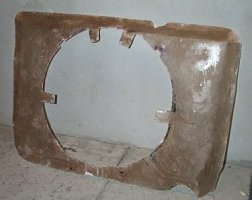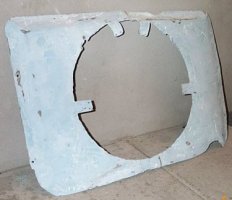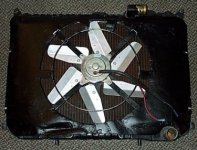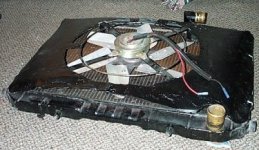Custom Electric Fan Shroud
Shrouds are important. Regardless of what some people may tell you, they are for more than just protection from getting your hands chewed up by the fan. The better the system is "sealed" from air OTHER than from the front of the radiator, the better. You will have better cooling, more concentrated air flow, and every inch of the radiator will be affected at a stop, rather than just those fins directly in front of the fan...the air will litterally be sucked up from the whole area of the radiator.

Another thing the shroud does is eliminate air being sucked in from BEHIND the radiator. Air being sucked from there does NOTHING for cooling (besides blowing a bit of air on the engine, which isn't what the fan is really for anyway. The fan is there to assist airflow through the radiator so as the coolant flows through, it is cooled.
I previously made a fan shroud using some old ducting sheet metal, but I was never over satisfied with the design and it had a few sharp edges and areas that didn't fit well on the radiator. This helped develop a small leak in my radiator :( So, while having to fix a small oil leak and clean up some paint overspray from a recent paint job, I decided to do a new fan shroud. I decided to use fiberglass as my medium. Many thanks to CutSnake for his instruction with this foreign (to me) material.
To use fiberglass, you first want a decent mould. Luckily, the metal shroud I made was good enough for an outline.
Fiberglass comes in sheets of cloth, just like any cloth you find in a fabric store. You can get about 8 sq. ft. for $3.97 from Walmart. I bought two packages of the cloth...one is a mesh cloth and one is woven. You also have to buy fiberglass resin, which is basically a lot of epoxy mix. Lay the fiberglass MESH on your mold (assuming you have one) and cut out the basic shape with about 2" of overlay for errors and stuff...you can trim it after it dries, which may be tedious, but worth it. I cut two long straight strips for my first layer, and then a skinnier strip to bond the two strips together (or you could just OVERLAY the two strips).
After cutting out the basic shape, cover the mould well with some CLINGWRAP (or similar product), lay the cloth down on the mould, mix the resin, and use a throw-away paint brush to healthily apply the resin onto the material. You'll want to wear gloves during the process (latex...TRUST ME). The resin will dry pretty quickly. If you want to, trim the excess (that you ARE SURE IS EXCESS) with some scissors while it's still wet (makes it much easier than waiting). The brushes will get hard just as quickly, so buy a few.
Once the first layer is well on, you can start randomly cutting the remaining MESH from the first packet and just slapping it on with some resin. These mutiple random layers will stregthen the project. After the second layer, I waited till the next day to let the project dry completely. Then I sanded all the sharp edges down and did some trimming. I placed the shroud onto the radiator and made sure all my cuts were precise and clean. Then I layed down the WOVEN layer of fiberglass, cut it to shape, mixed some resin and with a NEW throw-away brush, I applied the resin. Then, I let it dry throughly, and repeated some sanding and trimming.


After it is well trimmed, you can either follow the directions on the fiberglass resin can about PAINTING the surface, or you can just prime the project and paint it, OR just leave it unpainted. The OFFICIAL directions say to use some LIGHTWEIGHT FILLER (Bondo) and give a skim coat to the project.
Then you can sand it a bit, get more accurate with some FINE grade filler, and then paint. I just slapped it on, did some sanding, and painted it. I wasn't too worried about perfection.

The shroud still isn't perfect. I left a large section empty at the bottom because my previous installation of the fan had the bottom fins overlapping the bottom of the radiator more than it should've, so my first metal shroud was open at the bottom. I learned quickly that the mould has to be pretty much perfect. The fiberglass likes gravity, so the better the mould, the better the result.
Finally, I made provisions to make the shroud fit perfectly on the radiator. I drilled some holes and used zip ties IN SAFE PLACES where no abrasion would cause new leaks on the radiator. I also remounted the electric fan for a better fit and with more padding against abrasion.


Good Luck. More questions...just ask.